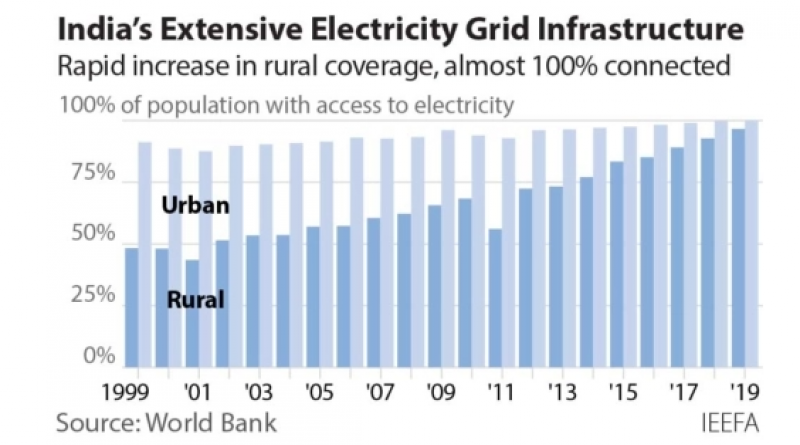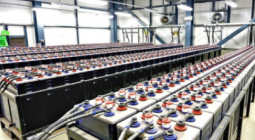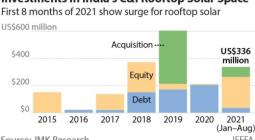India’s new gas infrastructure investment must be part of a balancing act

Vital fiscal and environmental queries in optimising role of gas in transition to clean energy for cooking and mobility
India’s strategy to cover unmet energy requirements by creating dual connections of gas and electricity requires a balancing act to ward off environmental and capital loss, according to a new report by the Institute for Energy Economics and Financial Analysis (IEEFA), with volatility of global gas prices increasing the urgency of pushing clean alternatives for cooking and mobility.
In the wake of the Indian government’s strong commitments to increase the share of gas in the country’s energy mix, IEEFA’s report says vital questions emerge about the fiscal risks of such a move, as well as the fossil fuel’s place in the scheme. At the same time, judicious investment in renewable energy looms as a means of leapfrogging legacy technology, delivering economic benefits and limiting emissions.
Growth in gas as a bridging measure to lower emissions may lead to stranded assets
The government is planning to expand gas’s share of the energy scene from the current 6% to 15% by 2030, with a particular focus on increasing use in the cooking and transport sectors. Major investments have begun in rapidly increasing the availability of this largely imported fossil fuel via infrastructure for importing, transport and distribution. Domestic production is tipped to rise thanks to new gas discoveries, even if the domestic price cap reduces the incentive for Indian producers to take on this risk.
The most recent amendment in the domestic gas price ceiling for new deep sea discoveries from US$3.92 mmBtu to US$6.13 mmBtu may temporarily incentivise private investment, but this may not be sustainable in the long term considering the increasing volatility in gas prices globally, based on which the domestic prices are revised with a lag.
As other countries commit to net zero carbon emissions in the longer term, India’s bridging measure to meet the goal of lowering carbon emissions with a push for gas may not be the best long term strategy.
In effect, the IEEFA report says, prioritising new gas infrastructure over the infrastructure cost advantage of distributed clean solar and wind, particularly in rural areas, may lead to stranded asset risks for the country.
Dependence on LNG risks energy security, current account and self-reliance goals
Report author, energy analyst Purva Jain says that optimising the use of available gas and investing in greening the electricity grid can reap greater long term results for the country.
“Top priority should go to the existing commitment to achieve 450 gigawatts of renewable energy by 2030,” says Jain.
India’s domestic gas peaked in financial year 2010/11 and even then the country imported 20% of gas needs. Last financial year, the import component was 54%. Increasingly fulfilling the gas needs of the country with imports – a sector with highly uncertain dynamics – puts both affordability and energy security in question, says the report.
“The reality of increasing LNG prices,” says Jain, “will make gas unaffordable for consumers and adversely affect the profitability of the suppliers.”
The latest 69% increase in the price ceiling for deep sea discoveries including the recently producing Reliance-BP KG-D6 block would also translate to higher gas price for consumers, says Jain, making even domestic gas an unaffordable proposition.
“A collapse in demand runs a big risk of gas-based assets remaining under-utilised and becoming stressed in the near future,” says Jain.
“This price volatility of LNG must be a key consideration before locking-in investments in gas infrastructure. India’s high and growing dependence on gas further diminishes benefits, risking not only India’s energy security but also its current account, currency value and self-reliance goals.”
Considering the entire lifecycle of exploration, transmission and distribution, Jain says, gas’s benefits are seriously diluted.
Cleaner substitutes needed for dirty, unhealthy fuels
There is an urgency for a switch to cleaner cooking fuels given the large proportion of the population still using solid fuels – which are harmful to health and the environment – for their cooking needs. The government’s transition push involves a shift for piped natural gas (PNG) in urban areas and in turn, increasing the availability of liquefied petroleum gas (LPG) in rural areas.
IEEFA notes there is a greater benefit in encouraging a switch to electric cooking in rural areas and diverting existing gas to the generation of electricity. Further, it says the government should encourage and facilitate the use of solar micro-grids, which become extremely cost effective with increased electricity use.
“The recent increase in gas prices which is expected to result in higher prices in the city gas distribution (CGD) segments may further delay consumers’ switch to PNG and CNG,” says Jain.
“Even if the immediate price impact is limited there would be further upward revisions in April 2022 based on the high gas prices prevailing right now.”
For a switch to cleaner mobility, the government hopes to increase the number of buses and taxis using CNG which might hit a roadblock now with ever increasing gas prices. The government also aims to increase the share of electric vehicles (EVs) in India and that appears to be a more tenable strategy.
Policy incentives for the increased electrification of public transport have also been put in place.
Jain says one fuel choice cannot be enough for India.
“A more staggered approach would achieve economies of scale and make the cleaner electric sources cost competitive without any support. The government should incentivise the purchase of EV passenger cars to lower emissions, increase acceptability, pique businesses’ interest in the sector and encourage investment in EV infrastructure.
Generated or renewable, electricity reduces reliance on energy imports
Increasing electricity use, the report concludes, provides economic and environmental benefits alike while reducing India’s dependence on energy imports. Electricity enables accelerated scaling up, given the country’s virtually 100% connection coverage. Going electric, whether generated or renewable, leverages existing infrastructure and avoids locking in a second energy distribution network.
Gas on the other hand has failed to reach scale in India over the past two decades, remaining a cooking and mobility option in limited urban areas, and is not assisting in lowering carbon emissions. As global cities start to shun gas and move to zero carbon emissions, the report says, investing in this fuel of the past is a strategy that needs to be evaluated with a long-term vision.
“Government policies have made investing in gas very lucrative at the moment but, from a longer-term business case perspective, such policies may change as global investment accelerates its exit from fossil fuels,” says Jain.
“Increasing gas prices could further risk gas investments as India’s price-sensitive consumers will switch to competitive options if gas becomes expensive.
“India should take this opportunity to leapfrog new gas networks in favour of electricity for cooking and mobility.”
Read the report: Role of Gas in the Transition to Clean Energy – Cooking and Mobility
6 October 2021
IEEFA




